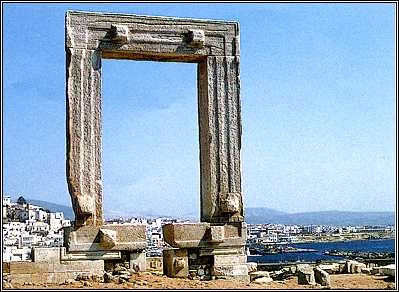| |
|

You are here :
Naxos >
Island Tour
> Sights >
Portara
Portara Naxos - Temple of
Apollo

The first walk which one should describe in
Naxos is what has become a traditional stroll at the Palatia or
Portara or Apollo Temple or the Baths of Ariadne: that is on the islet in front of
the harbour which you spot as soon as you arrive in Naxos, as the
huge marble gate, the Portara captures your eye. This is a very popular walk with the many tourists who come in Naxos.
It is known that in the intervening period between antiquity and
today the level of the Mediterranean has risen significantly and,
consequently, the low lying parts of what where coastal areas in
ancient times have been covered by the sea. So it would seem that
the Palatia islet was once a hill, lower than that of the "Kastro",
rising from a more extensive coastal plain.

In the 3rd millennium BC there was a settlement near the islet and
it is conjectured that the Palatia was the Acropolis of this
Cycladic village.
The area was subsequently deserted for many centuries. All we can
see today are the foundations and the huge portal of the "hundred
foot" temple begun around 530 BC by Lygdamis, tyrant of Naxos, but
never completed.
The "Portara" was built with four blocks of marble, each of a length
of over 6 metres and weighing 20 tones. Winches and scaffolding were
used to put them in place.
The threshold of the portal is higher than the floor of the temple,
a phenomenon who occurs elsewhere only in the case of the temple of
"Twin" Apollo at Miletus.
The temple was planned to be rectangular with pillars on the two
short sides. The Portara exactly faces Delos and this is seen as a
reference to Apollo, the temple being identified as the Delion
(temple of Delian Apollo), although some scholars associate it with
Dionysus, on the grounds that Naxos was the birthplace of Bacchus
and the island where Theseus left Ariadne inconsolable, until she
obtained the protection of Dionysus.
In the 6th century BC the Palatia served as good stronghold near the
town and it was there ,it seems, that the Erythraeans and the
Milesians established themselves in one of their attacks on Naxos.

However, a noble Naxiot lady, Polycrite, whom the leader of the
Erythraeans had fallen in love with and carried off, sent a message
from the enemy camp to her brothers, informing them of the day on
which the enemy would celebrate the Thargelia (a festival in honour
of Apollo) by baking a lead tablet in a loaf of bread. Thus Naxos
was saved.
The Palatia temple was converted into a Christian church in the 5th
or 6th century AD.
Under Frankish rule a great deal of marble was removed for building
in the Kastro area. This destruction continued under the Turks, with
the result that only the foundations remained, together with the "Portara",
which was so big that they did not have the means to demolish it.
Apart from its historical and archeological significance, the islet
of Palatia is unique in the Aegean as a spot from which to enjoy the
sunset and gaze at Paros and, when the horizon is clear, Delos,
Mykonos and Syros. |

